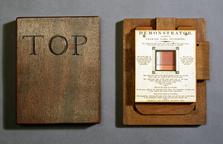

Plaster model of a surface generated by a semi-circle, 1876.
- maker:
- Charles Delagrave, Charles




Plaster model of a surface generated by a semi-circle made by Charles Delagrave, Paris, 1876.
The great age of mathematical surface models began in the mid 1860s. Especially in the German states, models were made in plaster, cardboard and wood and it became imperative for any self-respecting university or museum to buy sets of them. The mass-producer of many of these models, Alexander Brill, was dismissive of the French attitude of only being interested in models for engineering, as illustrated by this example which has obvious applications for staircase design. On the other hand, utilitarians lamented the aesthetic element in German education.
Details
- Category:
- Mathematics
- Object Number:
- 1876-414
- Materials:
- plaster-of-Paris
- Measurements:
-
overall: 171 mm x 256 mm x 256 mm,
- type:
- surface models (plaster) and mathematical models



